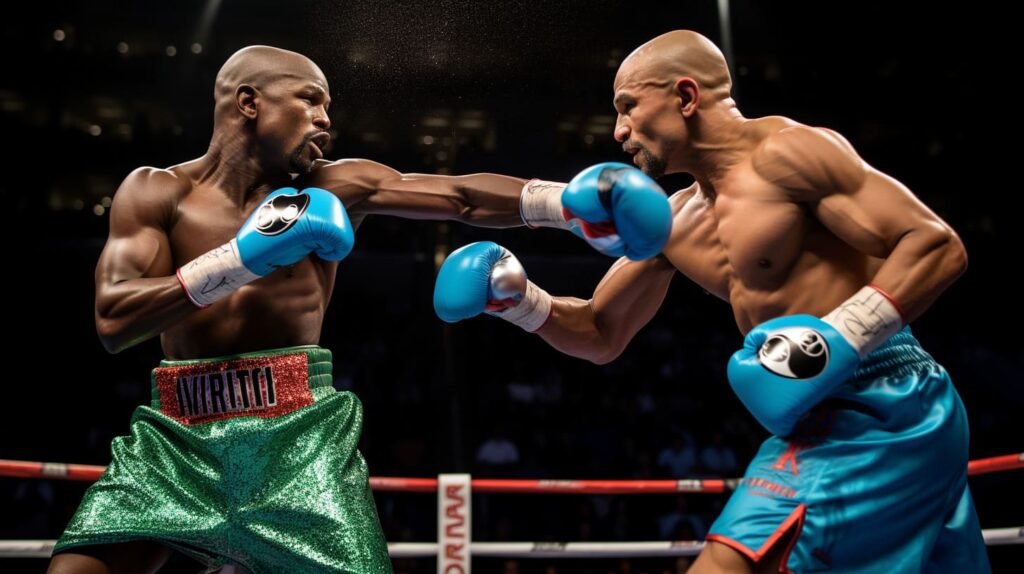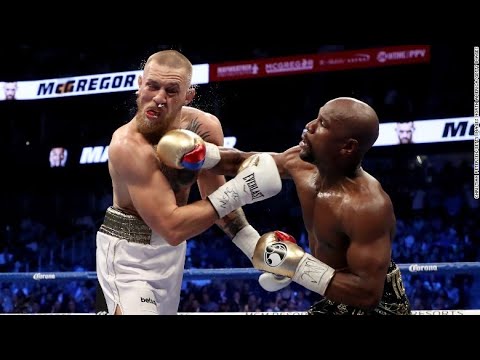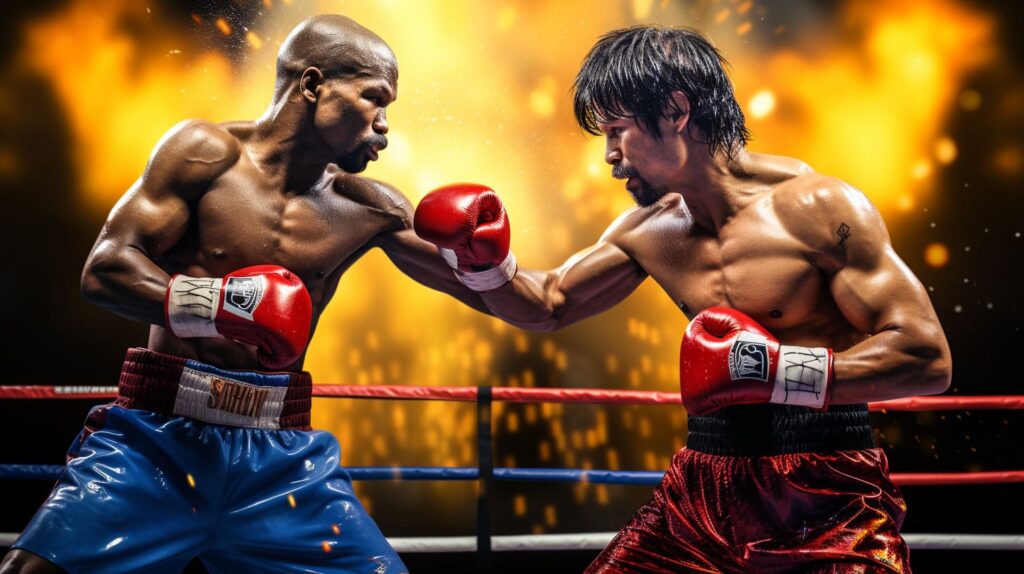Floyd Mayweather Jr. is a name synonymous with excellence in the world of professional boxing. With an undefeated record and a career spanning over two decades, Mayweather has left an indelible mark on the sport. His fighting style, characterized by exceptional defense, precision, and adaptability, has been a cornerstone of his success. Understanding Mayweather’s techniques and strategies offers valuable insights into what makes him one of the greatest boxers of all time.
Early Years and Defensive Foundation
Mayweather’s journey began in 1996 with a strong amateur background, which laid the groundwork for his defensive prowess. His early career, culminating in his first world title win in 1998, showcased his ability to outland opponents with quick combinations and hand speed. During these formative years, Mayweather’s style was more aggressive, focusing on an offensive approach to overwhelm his opponents.
Rise to Prominence
Between 2002 and 2007, Mayweather’s victories over formidable opponents like Diego Corrales and Jose Luis Castillo established him as a top contender. During this period, he began to emphasize defense more, using his jab and lateral movement to control fights. His transition to welterweight led to high-profile wins against Oscar De La Hoya and Ricky Hatton, cementing his status as a pound-for-pound great.
Move to Welterweight and Mega-Fights
Mayweather’s move to the welterweight division marked a significant evolution in his fighting style. His bouts against Shane Mosley, Victor Ortiz, and Canelo Alvarez highlighted his ability to adapt to different opponents and scenarios. These fights showcased his improved defensive techniques, including the effective use of the shoulder roll, which made it increasingly difficult for opponents to land clean shots.
Final Years and Legacy
In the final years of his career, Mayweather’s victories over Manny Pacquiao in 2015 and Conor McGregor in 2017 solidified his legacy. These fights demonstrated his refined ring generalship and ability to dictate the pace of the fight. Mayweather’s strategy often involved allowing opponents to tire themselves out while he conserved energy and capitalized on their mistakes.
Key Attributes of Mayweather’s Fighting Style

Several attributes contribute to Mayweather’s success and longevity in boxing:
- Exceptional Defense: Mayweather’s defensive skills, including his use of the shoulder roll, lateral movement, and ring control, have allowed him to avoid significant damage.
- Ring IQ: His intelligence and ability to adapt have enabled him to outmaneuver and outsmart opponents consistently.
- Precision Punching: Mayweather’s ability to land precise punches with high accuracy has been crucial in wearing down opponents.
- Conditioning and Endurance: His dedication to conditioning has kept him performing at a high level, even as he aged.
- Mental Toughness: Mayweather’s ability to remain focused and perform under pressure has been a hallmark of his career.
Recent Developments
In his recent fights, Mayweather has shown improvements in punching power and a slight shift towards a more aggressive approach. His influence on younger fighters is evident, as many up-and-coming boxers strive to emulate his techniques and strategies.
Summary of Milestones and Their Impact
| Period | Key Milestones | Impact on Fighting Style |
|---|---|---|
| Early Years | First world title in 1998 | Developed a solid defensive foundation |
| Rise to Prominence | Wins over Corrales and Castillo (2002-2007) | Focused more on defense, control of fight pace |
| Move to Welterweight | Victories over De La Hoya and Hatton (2006-2009) | Emphasized defensive skills, use of shoulder roll |
| Mega-Fights | Fights against Mosley, Ortiz, Alvarez | Showcased adaptability and precision punching |
| Final Years | Wins over Pacquiao and McGregor | Highlighted refined ring generalship and patience |
Floyd Mayweather Jr. has undeniably left a lasting legacy in the world of boxing. His unique fighting style, marked by exceptional defense, adaptability, and precision, has set him apart as one of the greatest fighters in the sport’s history. Understanding the evolution of his techniques and strategies provides a deeper appreciation of his contributions to boxing.
The ‘Mayweather Shuffle’ and Defensive Techniques
The Mayweather Shuffle stands as a testament to Floyd Mayweather Jr.’s defensive genius in the boxing ring. This unique movement involves a fluid, side-to-side lateral shift that helps him evade his opponent’s punches while maintaining a strong defensive posture. The shuffle is characterized by quick footwork, slight torso rotations, and subtle shifts in weight distribution. These elements work together to create an angular distance, making it difficult for opponents to land clean shots.
Key Elements of the Mayweather Shuffle
- Evasion: By continuously moving side to side, Mayweather can slip and bob around incoming punches, creating a dynamic defense that keeps his opponents guessing.
- Creating Angles: The lateral movements generate angles from which Mayweather can launch counterattacks. These angles disrupt his opponent’s rhythm and make it harder for them to predict his next move.
- Conserving Energy: The shuffle is energy-efficient, allowing Mayweather to maintain his defensive posture without expending too much energy on blocking or absorbing punches.
Evolution of the Shoulder Roll
Another cornerstone of Mayweather’s defensive arsenal is the shoulder roll. This technique involves rolling his shoulder to deflect incoming punches, reducing their impact. Over his career, Mayweather has continually refined this technique to match different opponents’ styles.
Phases of the Shoulder Roll
- Early Career: Mayweather’s shoulder roll was more pronounced, with a distinct rotation to deflect punches from traditional, linear attacks.
- Mid-Career: Against unorthodox fighters like Ricky Hatton, Mayweather adapted a more subtle “half-roll,” maintaining a stronger defensive position.
- Later Career: His shoulder roll became even more refined, incorporating a “slip-and-roll” motion. This allowed him to evade punches and immediately counterattack, often with devastating precision.
Recent Developments
Even in retirement, Mayweather continues to refine his defensive techniques. In a 2019 exhibition against Tenshin Nasukawa, he showcased a more aggressive style but still employed his signature defensive moves. Additionally, training footage with Devin Haney in 2020 revealed Mayweather’s ongoing emphasis on head movement and slipping punches.
These adaptations and continuous improvements underscore why Mayweather remains one of the best defensive fighters in boxing history. His techniques, from the Mayweather Shuffle to the evolved shoulder roll, exemplify his unparalleled skill in evading and countering opponents.
Footwork and Ring Generalship

Floyd Mayweather’s footwork is a key part of his boxing style, allowing him to create offensive angles and maintain control in the ring. His agility and ability to create space have always been strong, but over the years, his approach has become more dynamic and offensively oriented. Early in his career, his footwork was more about evading punches and maintaining distance. As he evolved, Mayweather started using his footwork to set up offensive opportunities, creating angles that catch opponents off guard.
Mayweather’s footwork drills are a testament to his dedication and adaptability. He incorporates several specific drills to enhance his ability to create offensive angles:
- Pivot Drills: These drills focus on pivoting on the back foot, allowing Mayweather to rotate his body and create angles for powerful punches.
- Lateral Movement Drills: By shuffling, bobbing, and weaving, he’s able to move side-to-side, making it difficult for opponents to predict his actions.
- Circle Drills: Practicing circling his opponent, Mayweather creates a “circle of death,” enabling him to strike from multiple angles.
- Angle Drills: These drills involve stepping to the side and pivoting on the front foot, helping generate power and precision in his strikes.
- Mirror Drills: By mirroring his opponents’ movements, Mayweather can use their own footwork against them, opening up counterattack opportunities.
Mayweather’s ring generalship complements his footwork, making him a master of controlling both the pace and the space in a fight. This control allows him to dictate the terms of engagement, forcing his opponents to fight on his terms. Analysts often highlight how his ring generalship and footwork lead to angled attacks that are both precise and unexpected.
Hand Speed and Accuracy
Floyd Mayweather’s hand speed and accuracy are critical components of his boxing style. Rapid combinations are particularly important in his approach, allowing him to overwhelm opponents with swift and precise punches. These combinations disrupt the opponent’s rhythm and create openings for more significant strikes.
Mayweather’s ability to throw rapid combinations begins with his rigorous training regimen. Shadowboxing is a core activity where he practices throwing multiple punches in quick succession. By doing this, he hones his hand-eye coordination and timing, making his combinations fluid and natural during actual bouts.

Plyometric exercises also play a crucial role. Exercises like jump rope and medicine ball throws enhance his explosive power, contributing to faster hand movements. This explosive power translates into the ability to deliver rapid-fire punches without sacrificing accuracy.
Another critical aspect of Mayweather’s training is focus mitt work with his trainer. These drills are designed to improve his hand speed and precision, ensuring that each punch lands accurately even at high speeds. The repetitive nature of these drills helps in muscle memory development, allowing Mayweather to execute rapid combinations instinctively during a fight.
Bag work further refines his ability to maintain speed and accuracy. Hitting the heavy bag, speed bag, and double-end bag, Mayweather practices throwing rapid combinations while adjusting the pace and angle of his punches. This not only improves his technique but also builds endurance, enabling him to maintain his speed and precision throughout the fight.
Mayweather’s statistics offer a testament to the effectiveness of his rapid combinations. According to CompuBox, he lands an average of 45% of his punches, a remarkable feat compared to the 30% average for other top boxers. His hand speed, estimated at around 1,000 punches per minute, far exceeds the average of 600-700 punches per minute for other top fighters. These metrics highlight how his emphasis on rapid combinations contributes to his successful boxing career.
Feinting and Misdirection

Floyd Mayweather’s mastery of feinting is a cornerstone of his boxing style. Effective feinting techniques create openings and manipulate opponents into making mistakes. Here are some of the techniques he uses:
- Shoulder Roll Feints: This technique involves Mayweather using his iconic shoulder roll, making it seem like he is preparing to throw a punch. This maneuver tricks opponents into reacting defensively, which allows Mayweather to counter with a quick jab or hook.
- Hand Positioning Feints: By placing his hands in a position that suggests an imminent punch, Mayweather creates a false sense of security. When opponents brace for impact and lower their guard, he seizes the opportunity to strike.
- Footwork Feints: Mayweather’s quick footwork is another tool in his arsenal. By faking a step-back or step-forward, he misleads his opponent into thinking he is changing distance. This tactic opens up opportunities for him to counterattack or land a clean shot.
- Eye Contact Feints: Mayweather often makes eye contact with his opponents only to quickly look away. This subtle move creates a moment of hesitation, giving him an opening to land a quick punch.
Mayweather also employs head movements and psychological tactics to enhance his feinting:
- Slipping and Bobbing: His quick head movements make opponents miss and create counterpunching opportunities.
- False Confidence: By displaying an air of nonchalance, he encourages opponents to become overaggressive, leading to openings for counterattacks.
- Mind Games: Mayweather uses trash talk and psychological tactics to unsettle his opponents, affecting their focus and making them more vulnerable to his feints.
- Reading Body Language: He is adept at anticipating his opponent’s moves by reading their body language, allowing him to plan his feints and counters effectively.
Successful examples of Mayweather’s feints can be seen in his fights against Manny Pacquiao, Canelo Alvarez, and Oscar De La Hoya. In each of these bouts, his ability to deceive and outmaneuver his opponents played a key role in his victories.
Counterpunching Skills
Timing and precision in counterpunching are hallmarks of Floyd Mayweather’s boxing style. His ability to land precise counterpunches stems from several key factors.
First, Mayweather’s defensive mastery is crucial. He expertly slips, bobs, and weaves around his opponents’ attacks, creating perfect opportunities for counterpunches. This defensive prowess not only keeps him safe but also positions him to strike back effectively.
Footwork is another essential component. Mayweather’s footwork allows him to create distance and angles, making it difficult for opponents to land clean shots. His ability to pivot and rotate enables him to set up counterpunches from unexpected positions, catching his opponents off guard.
Hand speed and reaction time are also critical. Mayweather’s hands are incredibly fast, and his reaction time is unmatched. This allows him to respond quickly to his opponents’ mistakes with precise, high-velocity punches. His counterpunches are often thrown with pinpoint accuracy, making them difficult to defend against.

Mayweather’s ring generalship adds another layer to his counterpunching skills. He expertly controls the pace and distance of the fight, using his jab to dictate the range. This control creates additional opportunities for counterpunches as his opponents struggle to keep up with his tactical movements.
Preparation and study play significant roles as well. Mayweather meticulously studies his opponents’ styles, strengths, and weaknesses. He prepares extensively for each fight, developing strategies to exploit his opponents’ mistakes and capitalize on counterpunching opportunities.
Finally, Mayweather’s vast experience and high ring IQ enable him to read his opponents’ movements and anticipate their attacks. This allows him to time his counterpunches with remarkable precision.
Notable counterpunching moments in his career include his fights against Canelo Alvarez, Marcos Maidana, and Manny Pacquiao. These bouts showcased his ability to land sharp, precise counterpunches in response to his opponents’ aggressive attacks. Over the years, Mayweather has refined his counterpunching strategy, incorporating more defense, patience, and feints to create uncertainty and capitalize on opportunities.
Adaptability in Fights
Floyd Mayweather’s adaptability in the ring is one of his defining features. His approach starts long before the fight through meticulous study and preparation.
Mayweather relies heavily on film study. He watches extensive footage of his opponents’ previous matches, identifying their strengths, weaknesses, and tendencies. This helps him anticipate their moves. His team, including his father and trainer, supports him with detailed scouting reports, enriching his understanding of his opponents’ habits and techniques.
In training, Mayweather hires sparring partners who imitate his opponents’ styles. This allows him to practice and refine strategies tailored to each specific challenge. Physical conditioning also plays a key role, ensuring he has the endurance and agility to adapt during the fight.
In terms of mental preparation, Mayweather works on his focus and calmness under pressure. This mental toughness enables him to stay composed and make mid-fight adjustments, which often turn the tide in his favor.
Examples of his in-fight adaptability are numerous. Against Manny Pacquiao in 2015, he adjusted his defense to handle Pacquiao’s aggressive southpaw style. By using a high guard and lateral movement, he successfully neutralized Pacquiao’s powerful left hand. In his 2013 bout with Canelo Alvarez, he kept Canelo at bay with his jab and adjusted his footwork to evade aggressive pressure.
Recent exhibitions also showcase Mayweather’s adaptability. In his 2021 exhibition against Logan Paul, he used his jab to manage Paul’s unorthodox style and lack of experience. Against Tenshin Nasukawa in 2018, he leveraged his footwork to evade attacks and land precise counterpunches. His 2017 match with Conor McGregor saw him switch to a more aggressive approach mid-fight, landing key combinations to gain control.
Mayweather’s ability to study, prepare, and adapt makes him a formidable opponent, capable of countering various strategies and styles.
Recent Developments in Mayweather’s Style
Throughout his career, Floyd Mayweather was known more for his defensive prowess than his knockout power. However, there were notable improvements in his punching power over time. These improvements can be attributed to several key factors:
- Training Regimen: Mayweather’s training included advanced strength and conditioning exercises. Weightlifting, plyometric drills, and specific punching exercises helped him build the necessary muscle to increase his punching force.
- Technique Refinement: Over the years, Mayweather honed his punching technique. He focused on aspects such as footwork, rotation, and follow-through. Proper technique allowed him to deliver more powerful and precise punches without compromising his defensive stance.
- Strategic Adaptation: As Mayweather gained more experience, he adapted his fighting strategy. He became more willing to engage in aggressive exchanges, which allowed him to throw more powerful shots. This strategic shift was evident in his victories over fighters like Ricky Hatton and Victor Ortiz.
- Experience and Confidence: With experience came confidence. In his later fights, Mayweather showed a willingness to take more risks, knowing he could land powerful blows effectively. This confidence in his abilities led to more dominant performances and stoppages.
Impact on Fight Outcomes
The improvements in Mayweather’s punching power had a noticeable impact on his fight outcomes:
- More Stoppages: Increased punching power led to more fight stoppages. Notable examples include his wins against Ricky Hatton and Victor Ortiz.
- Strategic Domination: Greater punching power allowed Mayweather to control fights more decisively. He could wear down opponents with precise, powerful shots, leading to convincing victories.
- Enhanced Reputation: Demonstrating improved power helped solidify Mayweather’s reputation as an all-rounded boxer, capable of both defensive mastery and offensive effectiveness.
These developments in Mayweather’s punching power were integral to his later successes and helped cement his legacy as one of boxing’s greatest.
Conclusion: Recap of Mayweather’s Key Boxing Techniques and Strategies
Floyd Mayweather Jr.’s boxing career is marked by an evolution in style and technique that has left a lasting impact on the sport. Let’s break down the key elements that define his success and how they have evolved over time.
Early Years (1996-2002): Speed and Aggression
In the initial phase of his career, Mayweather relied heavily on his exceptional hand speed and agility. His style was aggressive, characterized by rapid combinations and lateral movement. This approach allowed him to outmaneuver his opponents quickly and effectively.
Key techniques during this period included:
- Rapid Combinations: Utilized his quick hand speed to land multiple punches in rapid succession.
- Lateral Movement: Consistently moved side-to-side, making him a difficult target.
His aggressive approach and quickness set the stage for his early dominance in the ring.
Middle Years (2002-2009): Defensive Mastery
As Mayweather gained experience, his style evolved to emphasize defense. He became known for the shoulder roll technique, which allowed him to deflect punches with his shoulder while positioning himself for counterattacks. This period saw him shift from an aggressive offense to a patient, counterpunching strategy.
Key techniques included:
- Shoulder Roll: Used his shoulder to block punches and set up counterpunches.
- Slip Punches: Mastered the art of slipping punches to avoid damage and create countering opportunities.
Mayweather’s defensive prowess made him one of the hardest fighters to hit and led to his reputation as a defensive genius.
Prime Years (2009-2015): Complete Control
During his prime, Mayweather refined his techniques and brought his defensive skills to new heights. He incorporated feints, head movements, and body rotation to evade punches while controlling the pace of fights. His jab became a crucial tool in dictating distance and tempo.
Key elements included:
- Feints and Head Movements: Used to mislead opponents and create openings.
- Jab Control: Utilized his jab not just for offense but to manage the ring and keep opponents at bay.
These years saw Mayweather at his most complete and dominant, showcasing a blend of offense, defense, and ring generalship.
Later Years (2015-2017): Experience and Ring Generalship
In the twilight of his career, Mayweather leveraged his vast experience and ring generalship to maintain his unbeaten record. He often used his jab to set up powerful right hands and exploited opponents’ mistakes.
Key strategies included:
- Ring Generalship: Masterfully controlled the ring, dictating the pace and positioning of fights.
- Power Punches: Focused on landing effective power punches, particularly his right hand.
Mayweather’s ability to outthink and outmaneuver opponents highlighted his strategic brilliance and cemented his legacy.
Lasting Impacts on Modern Boxing
Mayweather’s influence extends beyond his own career. His emphasis on defense, ring generalship, and technical precision has shaped modern boxing:
- Defensive Emphasis: Many fighters now prioritize defense and counterpunching, inspired by Mayweather’s success.
- Ring Generalship: His control of the ring has raised the bar for fighters’ ring IQ and strategic planning.
- Technical Refinement: Fighters are increasingly focusing on the technical aspects of the sport, striving for the same level of skill and precision.
Recent Developments: Adaptability and Entertainment
In his recent fights, Mayweather made noticeable adjustments:
- More Aggressive Approach: Took the initiative in seeking knockouts or stoppages.
- Use of Power Punches: Incorporated more powerful right hands.
- Experimentation: Tried different styles, including more orthodox stances and uppercuts.
- Entertainment Focus: Engaged in more fan-friendly exchanges to please the audience.
These changes show Mayweather’s adaptability and his willingness to evolve, even late in his career.
Summary of Key Techniques
Let’s summarize the key techniques and strategies that define Floyd Mayweather’s boxing style:
| Technique/Strategy | Description |
|---|---|
| Rapid Combinations | Quick hand speed to land multiple punches in succession. |
| Lateral Movement | Side-to-side movement to avoid being a stationary target. |
| Shoulder Roll | Using shoulder to block punches and set up counterattacks. |
| Slip Punches | Evading punches by slipping them to create countering opportunities. |
| Feints and Head Movements | Misleading opponents to create openings. |
| Jab Control | Using the jab to dictate pace and distance. |
| Ring Generalship | Mastering the ring to control positioning and tempo. |
| Power Punches | Focus on landing effective and powerful punches, especially the right hand. |
Conclusion
Floyd Mayweather Jr.’s boxing style is a masterclass in evolution and adaptability. From his early days of speed and aggression to his later years of defensive mastery and strategic brilliance, Mayweather has set new standards in the sport. His lasting impact on boxing is evident in the defensive emphasis, ring generalship, and technical precision seen in modern fighters. As he continues to influence the sport, Mayweather’s legacy as one of the greatest boxers of all time remains firmly intact.
Additional Resources
Diving headfirst into the world of boxing, especially learning about Floyd Mayweather’s iconic style, is like stepping into a ring with a multitude of angles to tackle.
Books
- “The Art of Boxing: Your Guide to the Sweet Science“ by Bobby Mayne – While not solely about Mayweather, this book covers a myriad of boxing techniques with clarity and depth, which you can find mirrored in Mayweather’s approach.
- “Boxing’s Greatest Fighters“ by Bert Sugar – Get to know other greats alongside Mayweather and see how his style compares to some of the best in the game.
Articles
- Boxing Scene – Keep an eye out for articles on Mayweather’s technique, training, and fight analysis that crop up on Boxing Scene. It’s a hub for all things boxing, so you’re bound to find some golden nuggets on Mayweather’s style.
- ESPN Boxing – ESPN often features retrospectives on fighters’ careers, and Mayweather has been in the spotlight numerous times. Search their archives for detailed reports and commentary.
Videos
- Mayweather’s Defensive Genius – Explore numerous breakdowns on Youtube of Mayweather’s defensive prowess, the shoulder roll, and his unparalleled ability to control the range and pace of a fight.
Websites
- ExpertBoxing – Packed with guides and tips on boxing strategies, though not an exhaustive resource on Mayweather, this site will give you insights on the kinds of techniques he mastered.
- FightHype – This website is great for interviews and features on Mayweather that can give you some perspective on his mental game and training habits.
Documentaries
- “Mayweather” – A telling documentary that will take you into the life and mindset of Floyd ‘Money’ Mayweather, giving you firsthand insight into why his boxing style is so effective.
- “Counterpunch“ on Netflix – While broader than just Mayweather, this film provides context to the world of boxing that helped shape styles like Mayweather’s.
Each of these resources offers a different piece of the Mayweather puzzle. Whether you’re a boxing aficionado or a newcomer to the sport, there’s something to learn about the precision and discipline behind Floyd Mayweather’s boxing style. Make sure to check them out to get a full picture of what made his style so successful in the ring.

